Music Tempo Marks
Home » Piano Notes » Music Tempo Marks
The Italian word Tempo literally means "RATE OF SPEED".
But the word "Tempo" actually means much more.
In the previous lessons we've learned to read notes and play them according to different dynamic signs. So far so good, but we're still missing something that will help us to understand the concept of the whole picture.
Music Tempo Piano Lesson (Allegro, Moderato, Andante, Adagio) by pianoplayit
Music is moving through time. The music tempo informs us how fast or slow we have to play and what is the MOOD that defines a musical piece.
Here below, I'm going to add a list of a few MUSIC TEMPO Expressions.
These words describe how fast or slow you have to play and what kind of mood you should be producing.
If you just started playing the piano, here are the first four music tempo marks you should know.
ALLEGRO = Quickly, Happily
MODERATO = Moderately
ANDANTE = Moving along. It literally means "At a walking paste".
ADAGIO = Slowly
You'll usually notice the music tempo of a piece at the beginning above the first staff.

If you to take your next step in reading piano notes you should definately check out the Rocket Piano Ultimate Learning kit. Rocket Piano provide an amazingly handy and effective piano course on various issues such as reading piano notes, playing piano by chords, piano technique and more.
You're going to love the way they work systemically with the help of their
useful audio and video files that are short and to the point. By working
with Rocket Piano you basically guarantee that you'll become pro at reading piano notes
(And the big bonus is you'll learn to play piano by ear as well).
Check out the Ultimate Piano Learning Kit of Rocket Piano Now!
Here are a few pieces with these four basic music tempos
|
Click here if you haven't signed to Piano Playground, our free E-zine yet make sure you do that in order to get the username and password codes for the piano sheets I provide here under. |
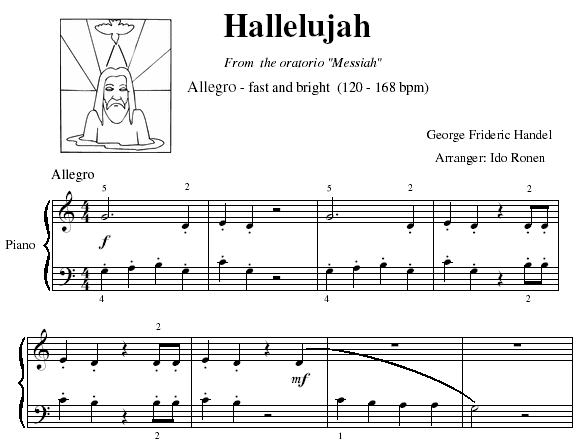
Click here to download the Halelluja by Handel full piano sheet for free.
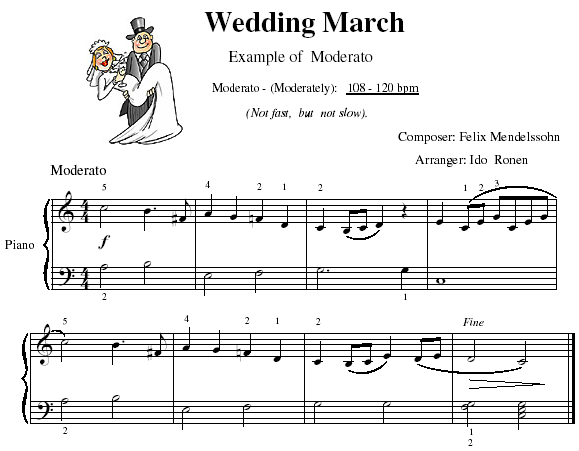
Click here to download the Wedding March by Mendelssohn full piano sheet for free.
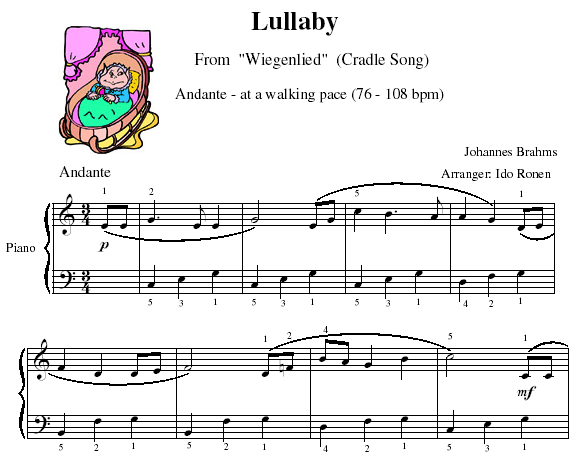
Click here to download Lullaby by Brahams full piano sheet for free.
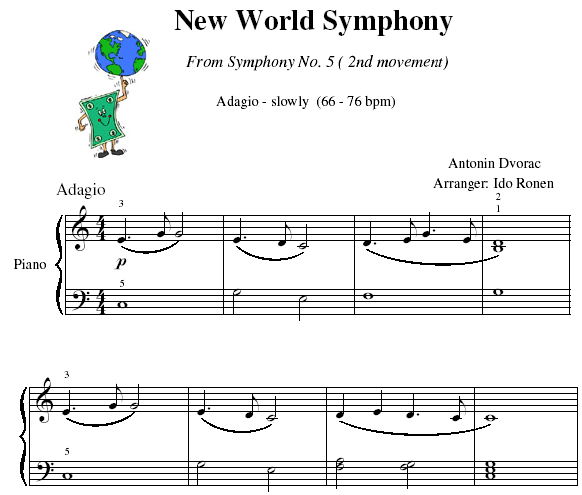
Click here to download The New World Symphony by Dovarac full piano sheet for free.
Now, if you're a bit confused with the music tempo expressions, here's an example of how a music tempo expression suggests both the rate of speed and the mood of a piece.
Let's take Presto and Allegro for example. Both these tempo expressions direct you to playing pretty fast (When you play presto you have to be a bit faster though).
However the word allegro has an extra meaning. It means you have to play in a joyful manner as well (Allegro means joyful in Italian).
The word presto means that you actually have to play in a virtuosic style.
At first, the rate of speed was indicated only by the Italian tempo expressions but later on this has changed, once the metronome was invented in the first half of the 19th century.
It was then possible to measure music tempos in a more accurate manner and say how many beats we should play per minute.
In other words, the higher the tempo, the larger the number of beats that should be played in a minute, and, therefore, the faster a piece should be played. This term is also called BPM (Beats Per Minute).
However, the Italian words are still written today to state the mood of the piece.
Changes in Music Tempo
The Fermata
The beauty of classical music is that it provides an elastic feeling of time.
That means that the tempo of a piece can occasionally change.
Let's take the FERMATA for example. When the sign of a FERMATE appears above a note you should hold the note longer than its value.
The Fermata gives the note an extra attention as if to let us know how beautiful a certain musical note is in a piece.
At the end of many pieces we use the fermata as well to prolong the ending which creates a natural fade-out of the sound at the last note/chord.
Ritardando
The Italian word Ritardando means GRADUALLY SLOWING THE TEMPO.
It is often abbreviated retard. or rit.
When we're expected to RESUME THE ORIGINAL TEMPO we'll see the words a tempo above the place.
Here's a common example of a Fermata sign and a Ritardando sign in the song Happy Birthday to You.
Click here if you haven't signed to Piano Playground, our free E-zine yet make sure you do that in order to get the username and password codes for the piano sheets I provide here under.
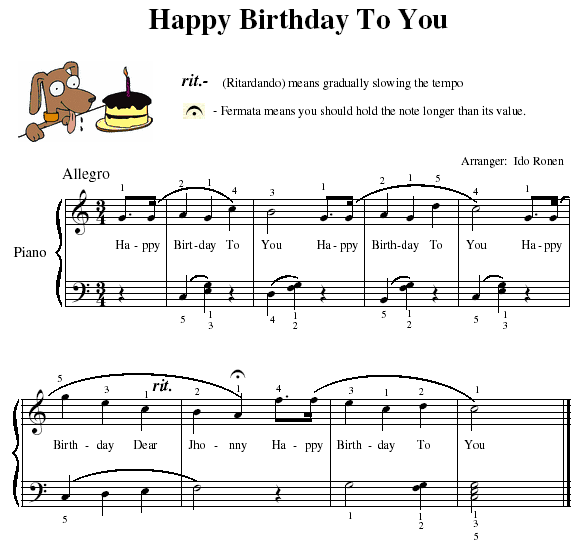
Click here to download the Happy Birthday full piano sheet for free.
Here's a list of other Music Tempo Marks which state a change in a tempo.
Accelerando - speeding up (abbreviation: accel.)
Allargando -growing broader; decreasing tempo, usually near the end of a piece
Calando - going slower (and usually also softer)
Cantabile - in singing style (lyrical and flowing)
Meno mosso - less movement or slower
Mosso - movement, more lively, or quicker, much like piu mosso, but not as extreme
Più mosso - more movement or faster
Precipitando - hurrying, going faster/forward
Rallentando - gradual slowing down (abbreviation: rall.)
Ritardando - immediate slowing down (abbreviation: rit. or more specifically, ritard.)
Ritenuto - slightly slower; temporarily holding back.
(Note that the abbreviation for ritardando can also be rit.
Thus a more specific abbreviation is riten. Also sometimes ritenuto
does not reflect a tempo change but a character change instead.
Rubato - free adjustment of tempo for expressive purposes
Stretto - rushing ahead; temporarily speeding up
Stringendo - pressing on faster
A List of Tempo Markings
Prestissimo - extremely fast (more than 200bpm)
Vivacissimamente - adverb of vivacissimo, "very quickly and lively"
Vivacissimo - very fast and lively
Presto - very fast (168- 200 bpm)
Allegrissimo - very fast
Vivo - lively and fast
Vivace - lively and fast (~140 bpm)
Allegro - fast and bright or "march tempo" (120 - 168 bpm)
Allegro moderato - moderately quick (112 - 124 bpm)
Allegretto - moderately fast (but less so than allegro)
Allegretto grazioso - moderately fast and gracefully
Moderato - moderately (108 - 120 bpm)
Moderato espressivo - moderately with expression
Andantino - alternatively faster or slower than andante
Andante Moderato - a bit faster than andante
Andante - at a walking pace (76 - 108 bpm)
Tranquillamente - adverb of tranquillo, "tranquilly"
Tranquillo - tranquil
Adagietto - rather slow (70 - 80 bpm)
Adagio - slow and stately (literally, "at ease") (66 - 76 bpm)
Larghetto - rather broadly (60 - 66 bpm)
Grave - slow and solemn
Lento - very slow (40 - 60 bpm)
Lento Moderato - moderately slow
Largo - very slow (40 - 60 bpm), like lento
Larghissimo - very very slow (20 bpm and below)
Mood Tempo Markings
Affettuoso - with feeling/emotion
Agitato - agitated, with implied quickness
Appassionata - to play passionately
Dolce - sweetly
Espressivo - expressively
Furioso - to play in an angry or furious manner
Giocoso - merrily, funny
Lacrimoso - tearfully, sadly
Leggiero - to play lightly, or with light touch
Maestoso - majestic or stately (which generally indicates a solemn, slow movement)
Morendo - dying
Pesante - heavily
Sautille/ Saltando - jumpy, fast, and short
Sostenuto - sustained, sometimes with a slackening of tempo
Spiccato - slow sautille, with a bouncy manner
Vivace - lively and fast, over 140 bpm (which generally indicates a fast movement)














